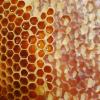Hyaluronic acid has the simplest structure in comparison to other glycosaminoglycans (GaGs). It consists of sequentially joined glucuronic acid and acetylglucosamine monosaccharides. Those saccharide building blocks are naturally synthesized in the cells. Disodium Acetyl Glucosamine Phosphate with Glucose may be an external source of building blocks (precursors) for HA synthesis stimulating the process. The dermal cell won't spend energy on the synthesis of precursors, instead of that it'll join blocks and produce Hyaluronic acid.
HA is a natural and essential humectant that enhances the moisture-binding capacity of the skin providing optimal hydration, surface smoothness, and elasticity. It also activates the synthesis of collagen and elastin fibers providing skin volume, plumpness, and firmness.
Hyaluronic acid has antioxidant and anti-inflammatory effects. It traps free radicals and inhibits inflammatory processes. HA combats against photoaging and promotes regenerative and renewal processes.


